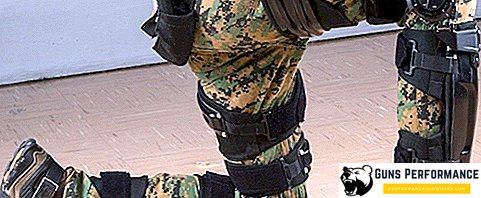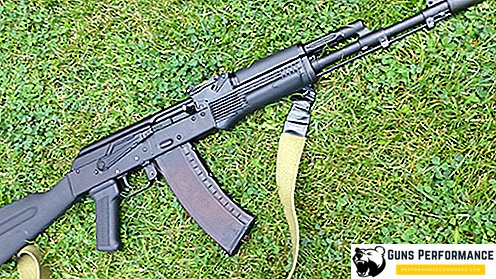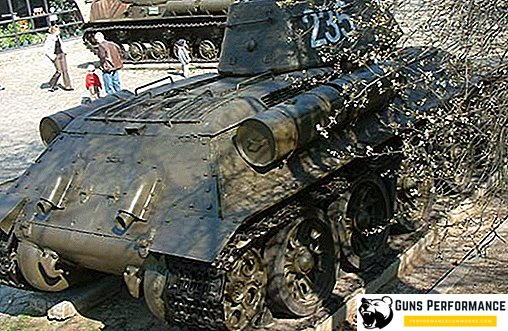Russian folk clothing has a long history, it has many common features with the things that were worn by the ancient Slavs. The shape of the Russian costume corresponded to the way of life of the people and its geographical position. For example, in the more southern regions things differed in brightness, each element of the Russian wardrobe was thought out with great love. In the northern regions, clothing was a match for the difficult conditions of life — darker and darker. Residents of mountainous regions richly decorated their costumes with embroidery, as there were many different dangers in the mountains of man. It was from those times that the saying "meet by clothes ..." went, since it was possible to guess not only the origin of a person, but his social and family status by the elements of the decoration of the dresses.
Dresses of the ancient Slavs and their features
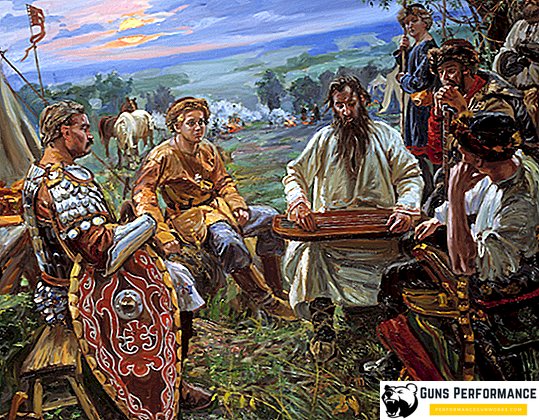
The first Slavic elements of apparel were made of leather and fur, it was the only readily available material in antiquity. At that time, the owner’s status could be determined by the type of skins used:
- Ordinary congregation wore things from the skins of domestic animals;
- Warriors preferred clothing made from predator skins; wolf and bear skin with fur were especially popular;
- Ancestral nobility, leaders and princes dressed in fur of fur animals.
Starting from the 6th century AD The main material for the manufacture of Slavic clothing are flax and hemp. The poorest segments of the population wore gray clothes, the richer ones were white, from refined flax, because at that time the technology of dyeing fabrics was still unknown. In the XI-XIII centuries in Russia began to spread woolen fabric sermyaga or fuss. By this time, the appearance of multi-colored fabrics, as the Slavs began to actively trade with the Byzantine Empire. The costumes of the Eastern Slavs were distinguished by their good quality and pretentiousness, this was influenced by the neighborhood with Rome, Greece and close ties with the Scandinavian region. Princes, nobles and warriors tried to dress in foreign silks.
The Slavic style of clothing is most easily traced by female models, although archaeological excavations provide very scarce information on this subject, and one has to be guided by drawings in written sources. The main element of the costume of the ancient Slavs (and men too) was a long shirt, often decorated with coastal patterns and embroidery with folk motifs. Types of shirts:
- Festive;
- Everyday;
- Wedding;
- Funeral;
- Pose;
- Entrained.
The first shirts were an ordinary piece of cloth, bent in half, with a hole for the head and a belt. After a few centuries, they learned to sew the sleeves.
Female Slavic clothing was decorated with Volkhov and coastal embroidery, stripes and ribbons were often used. Traditional Russian sundresses began to be mentioned only in the XVI century, cuffs and slanting gates appeared in the XVII century. With the advent of dyeing technology, the main color was red and about 30 of its shades. Children's Slavic clothing differed from the adult only in embroidery and consisted, as a rule, of one shirt "to toe."
Thanks to the excavations, Slavic jewelery is known all over the world, and local jewelers have achieved unprecedented heights in the manufacture of which, even Greek jewelers often copied them. Most often met:
- Temporal rings - a specific decoration of headdresses, fastened near the temples. They were worn by single Slav girls;
- Hryvnia - neck hoop, made of metal, most often of bronze and silver. Scientists believe that these jewels carried a deep sacred meaning, as often the hryvnia was not removed throughout life. According to one version, gold and silver jewelry was allowed to be worn only by representatives of the supreme nobility;
- The hoop earrings are large but light trinkets made of wire could be woven;
- Pendants - pendants of metal of large size, usually played the role of amulets;
- Bracelets - the most common Slavic jewelry, most often found during excavations, are male and female;
- Rings of various sizes and shapes.
Features of the Slavic national attire
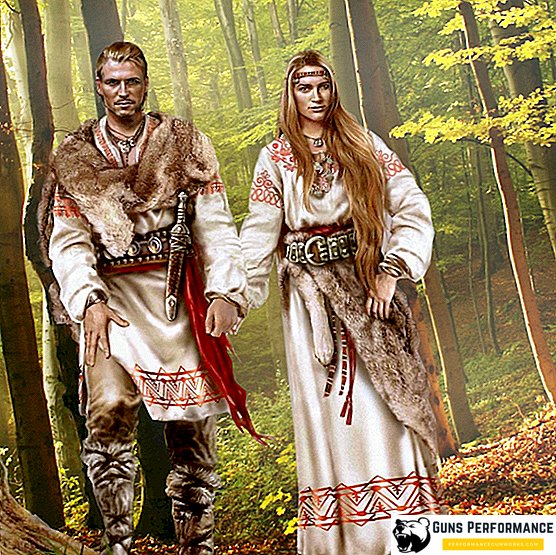
With the advent of the principalities in the territory of modern Russia, Ukraine and Belarus, the Slavic attire began to share on the characteristic features characteristic of the Russian national costume:
- For immediate use (everyday, mourning, wedding);
- By age (child, adult, for the elderly);
- By color range.
Embroidery with Slavic symbolism was most often made with red threads. In the southern regions begin to use a variety of vegetable dyes that can give a wide range of colors:
- Red;
- Blue;
- The black;
- Brown;
- Yellow;
- Green.
Decorative ornaments in the form of Christmas trees, bushes, stylized figures of animals and women began to be used as decorations.
Russian women's traditional costume
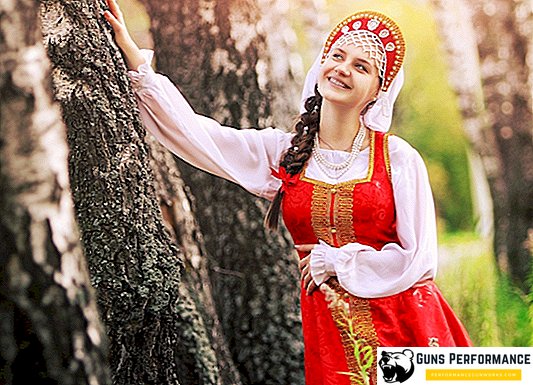
Female Russian costume is significantly different from the Slavic, new parts of the wardrobe appear:
- Aprons (they were also called curtains);
- Ponevy;
- Bibs;
- Sundresses;
- Suspended.
Initially, only noble women wore new elements, peasant women still managed a simple shirt, which eventually turned into a straight long dress. The shirt itself did not disappear, but became part of the underwear.
The Russian women's shirt was made only from poor peasants from unbleached linen, and almost every one had a festive white thing with various embroideries and ornaments. Clothes for everyday life, decorated with ornaments with birds and animals, was considered a special chic. The drawings could have a width of up to 30 cm, and each part of the embroidery that ran along the bottom of the product was decorated with its own ornament.
Aprons were the most beautiful items of clothing worn by women. This part of the costume was made of thick canvas, decorated with embroidery with ornaments and ribbons of silk. The edges of the curtain (apron) were decorated with a fringe of thread, multi-colored frills, and teeth of red or white lace.
Sundresses began to sew in the northern Russian provinces, where they are known from the XVIII century. Such an outfit was made of plain canvas, coarse calico, homespun wool or red dye. The monotony of this element of the female costume helped to highlight the multicolored colorful patterns on the shirts and aprons.
Poneva - a special type of skirt, worn around the waist. It was made of 3-5 pieces of fabric, stitched together on the hem, the upper edge of the skirt was bent and fastened, leaving inside a place for threading the belt of the cushion. Worn predominantly by married women, the girl could put on her clothes when she reached puberty or when she was married.
Outerwear:
- Zapona is a female wardrobe item made of colored canvas of rough manufacture, it was not sewn on the sides and was worn together with a belt. She was always shorter than a shirt, she skalted down below;
- Doucegrea - a short thing on the straps, like a sundress, worn over it. It was considered a holiday outfit, made of expensive patterned fabrics, most often had a decorative border;
- Letnik is patchwork clothing that only wealthy Russian women could afford. The main feature of the pilots were wide sleeves, richly decorated with pieces of velvet or satin, embroidered with pearls, gold or silver. Letnik had a beaver collar, often tinted in black;
- A fur coat is a winter type of an airnome, distinguished by narrow and long sleeves;
- Telogree - the same coat, only hinged, supplied with buttons or strings.
Women's hats and shoes
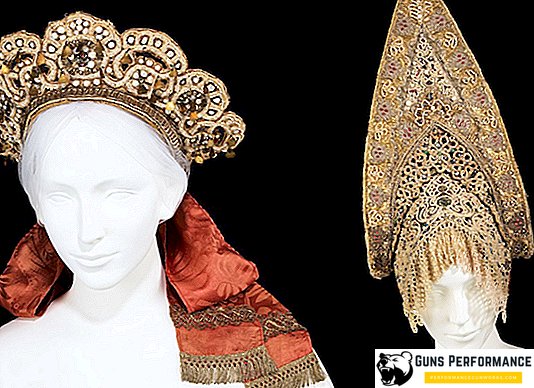
The headgear of the Russian national costume has much in common with the ancient Slavic traditions; it was from there that the custom of hiding the hair of married women and walking with bare head to the girls went:
- Kokoshnik - was worn by women only on holidays due to the fact that it was very heavy and expensive;
- The dog is a headdress of married women, a red or white stool was worn over it;
- Crown;
- Bandage;
- Quica;
- Cap with fur trim.
As shoes, women wore bast shoes with onions and obori, half boots, cats, boots. Expensive shoes decorated with red cloth or morocco.
Items of men's wardrobe in Russia
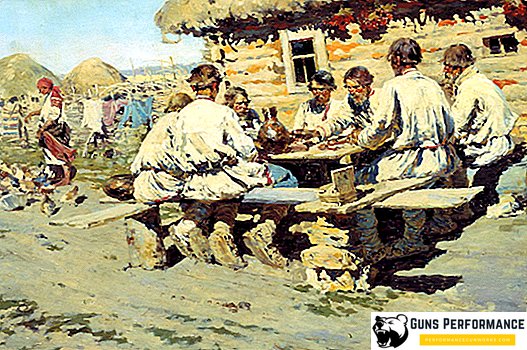
Men's peasant clothing in Russia differed little from the ancient Slavic national costumes, the main elements of which are:
- Shirt, cut out of several pieces of canvas. Working clothes had a gray color, and festive shirts were sewn of bright fabric, often red was used. Most of the seams were decorated with red edging, there were elements of coastal embroidery. A simple shirt could afford every peasant, the famous "kumachevye" - only a rich man. This basic element of the Russian costume was worn loosely, a narrow belt or a lace tied over it;
- Ports are traditional Russian trousers, which were sewn with narrow and narrowed ankles. Had a special lace-a downer, performing the role of a belt. The fly was also tied with a special ribbon. Below, the ports were refueled into onuchi, after which they were put on sandals. If a person had boots, they did not wind up. Since the 17th century, rich peasants and most merchants began to wear trousers of cloth or silk over their ports, often with lining;
- Zipun appeared in the northern part of Russia, was widely used in spring and autumn. He represented the outerwear of a semi-adjacent, down-extended silhouette, the length reached the knee and below;
- Kaftans - clothes for the rich, worn over the zipoon. Could differ from each other not only the finish, but also the appearance, were divided into home, regular, weekends. For the decoration of caftans they took twisted cords, buttonholes, buttons of precious metals and pearls.
Men's holiday items were often embroidered with red threads and braid, and from the 16th century other colors began to be widely used.
Men's traditional shoes
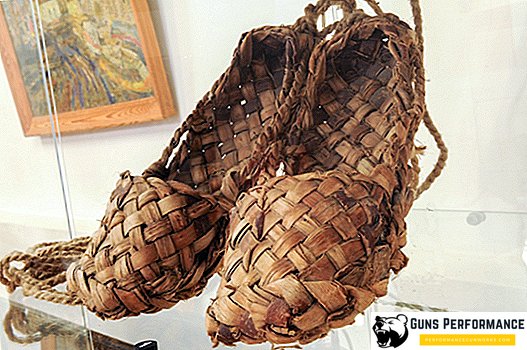
The most famous Russian national shoes are sandals. Most people think that they appeared in the days of the ancient Slavic pagans. In fact, the first written mention of the sandals belong to the year 985. The chronicle describes the case of the attack of Kiev Prince Vladimir on the Volga Bulgarians, who were shod in boots. The voivode then told the prince that he had to look for a tributary of bast shoes. From this we can conclude that in the 10th century bast shoes were worn by Krivichi, Radimichi and Dregovichi.
Another popular type of ancient shoe was the pistons - leather shoes, distributed throughout medieval Europe. There were pistons of several pieces of leather, as well as shoes from a single piece of skin - "Prabothies". Sandal-type shoes, borrowed from Byzantium, came across in Russia. During excavations, sometimes remains of boots with hard soles and iron shoes are found.
Warriors and rich people in Russia wore two boots of two kinds: soft, with an upper hood and sole, and boots of a complex cut with a back, leg, head, and sole. As for the world-famous felt boots, they appeared only in the 18th century in Siberia, having spread in the central provinces of Russia in the 19th century and becoming the peasants' favorite winter shoes.
Modern clothes in the Slavic style
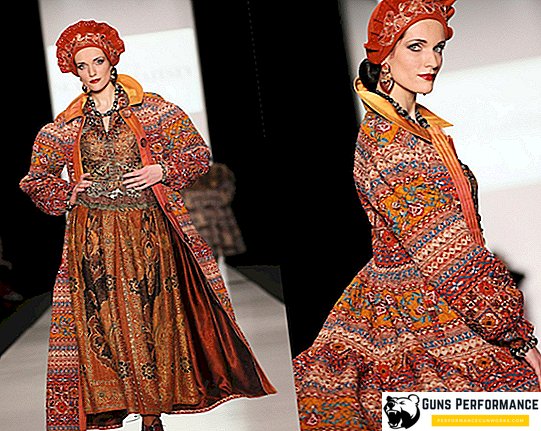
Now Russian folk trends in fashion are very popular all over the world. Of course, almost no one wears sundresses, kokoshniks and long braids, but the color of the traditional Russian costume is used in collections by many fashion designers. If men's clothing is limited to shirts with embroidery and belts, then women's fashion is represented widely:
- Fur coats made of natural and artificial fur of direct cut are in small, but stable demand. They have long sleeves with cuffs, a turn-down collar and a belt at the waist;
- The coat of natural fabric has nothing to do with the Russian women's national costume, but thanks to the embroidered patterns in the Slavic style and the fur trim of the collar and cuffs, it looks harmonious;
- Long dresses and maxi skirts in contrasting shades are often worn with Russian-style winter fur.
For women who are not ready to drastically change their appearance, there are secrets to giving the image of the Russian style on the basis of casual clothes, for this it is enough to use various accessories. You can throw on a head a painted Pavlovo Posad shawl, a fur hat of a classic round shape will also add traditional Russian features to the female image.
As shoes, women are advised to choose red boots to the knee. The best option would be shoes with sharp and slightly curved noses up.
All kinds of capes, vests, and veggies lined with fur will help to create a Russian image. Now, many fashion designers make summer collections of modern dresses and skirts, designed in ethno-style or with traditionally Russian decoration.
Real Russian folk costumes can be seen only in historical museums or at amateur concerts. It should be understood that the clothing of ancient Russia could not survive unharmed until our time, therefore many details were copied from the drawings and may not correspond to the real historical analogue.





